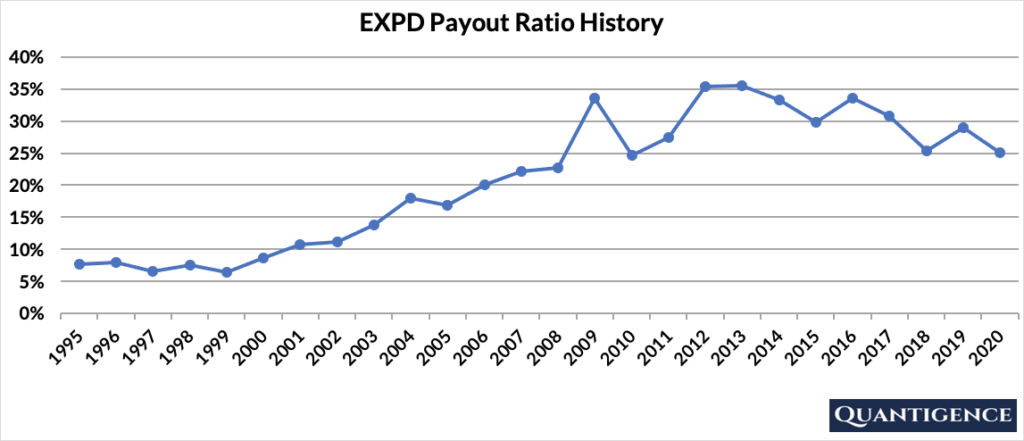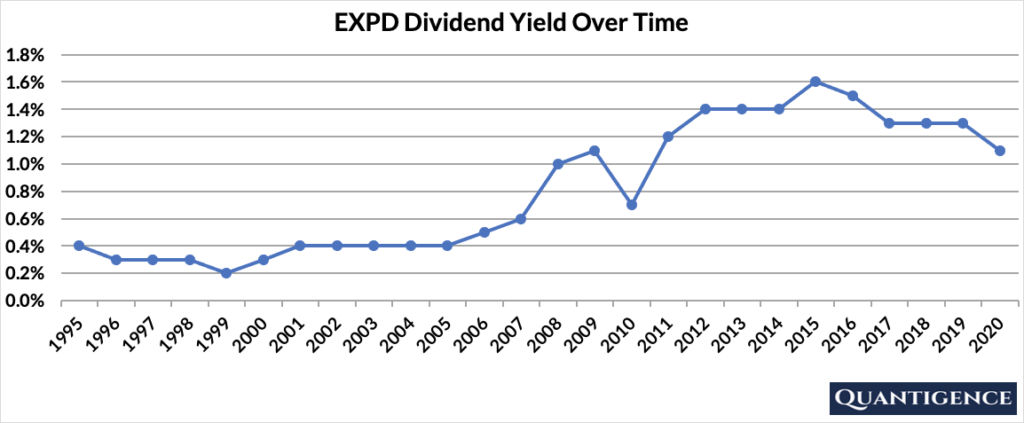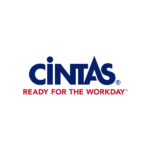Expeditors International of Washington (NASDAQ: EXPD) provides logistics services globally, including air freight and ocean freight services, intra-continental ground transportation, warehousing and distribution, customs brokerage and clearance, cargo insurance, specialized cargo monitoring and tracking, and other supply chain solutions. The company operates the following geographic segments:
| Segment | 2020 Revenue (USD billions) | Revenue % |
| North Asia | 3.84 | 38% |
| United States | 2.78 | 27% |
| Europe | 1.54 | 15% |
| South Asia | 0.99 | 10% |
| Middle East, Africa and India | 0.49 | 5% |
| Other North America | 0.33 | 3% |
| Latin America | 0.16 | 2% |
EXPD’s Dividend History and Payout Ratio
EXPD has a track record of paying and increasing dividends for 26 consecutive years, a record that makes it a newcomer to the prestigious club of dividend champions. In 2020, the company paid out only 25% of its profits in the form of dividends. This low payout ratio enables the company to keep growing its dividend in the future, even if earnings are not growing or temporarily declining.
In looking at the company’s payout ratio history over the past 25 years, it’s been relatively stable with a low average of 21%.

When Does EXPD Pay Dividends?
EXPD pays a semi-annual dividend typically announced in the first week of May and November. The ex-dates are around the last days of the same month, and payments are made around the middle of June and December.
What is EXPD’s Dividend Yield?
Dividend yield (the annual dividend paid divided by the share price) shows the 1-year income for a stock from dividends. In 2020, EXPD had a dividend yield of 1.1%, lower than our investment universe average of 1.8%. The stock’s historical yield has been moving between 0.2% and 1.6% with an average of 0.8%.

EXPD’s Dividend Growth Rate
EXPD has grown its dividend by an average of 10.0% every year for the past 10 years. That growth seems to be slowing with the annual average being 7.6% over the last five years. Below you can see the effect a 10-year growth rate of 10.0% has on EXPD’s dividend assuming a starting yield of 1.1%.
| Years | Dividend Growth | Yield Calculation | Yield % |
| Year 0 | 0% | 1.10% | 1.1% |
| Year 1 | 10.00% | 1.1%*1.100 | 1.21% |
| Year 2 | 10.00% | 1.1%*(1.100)^2 | 1.33% |
| Year 3 | 10.00% | 1.1%*(1.100)^3 | 1.46% |
| Year 4 | 10.00% | 1.1%*(1.100)^4 | 1.61% |
| Year 5 | 10.00% | 1.1%*(1.100)^3 | 1.77% |
| Year 6 | 10.00% | 1.1%*(1.100)^6 | 1.95% |
| Year 7 | 10.00% | 1.1%*(1.100)^7 | 2.14% |
| Year 8 | 10.00% | 1.1%*(1.100)^8 | 2.36% |
| Year 9 | 10.00% | 1.1%*(1.100)^9 | 2.59% |
| Year 10 | 10.00% | 1.1%*(1.100)^10 | 2.85% |
If you bought EXPD at a yield of 1.1%, an average 10-year dividend growth of 10.0% would mean your yield would be 2.85% 10 years from now. This is called “yield on cost,” and shows the yield you’re receiving on the original amount of money you invested.
How Strong is EXPD’s Dividend?
When evaluating dividend stocks, we use our own methodology which is based on Q-scores which consist of seven factors:
- Years paying and increasing dividends
- Market cap
- International sales
- Yield
- Payout ratio
- Five-year dividend growth rate
- Ten-year dividend growth rate
We calculate each of these factors and summarize them in a final proprietary Q-score. To learn more about how we calculate Q-scores, check out our piece on “7 Factors Used to Select Dividend Growth Stocks.”
The Q-score for Expeditors International of Washington is presently 14.6, the ninth-best Q-score in the industrials sector consisting of 16 dividend champions. We reward EXPD for its low payout ratio, international sales, and 10-year dividend growth rate. We penalize the company for its low yield. The rest of the factors are mediocre, so they contribute little to the final Q-score.
EXPD’s overall Q-score is not bad – it is higher than our universe average of 13.1 – but we are spoiled for choice in the industrials sector. As there are really excellent alternatives available to us, we don’t include EXPD in our final 30-stock dividend growth portfolio.
[optin-monster slug=”ziwrnabndtepsyq0fyai”]


